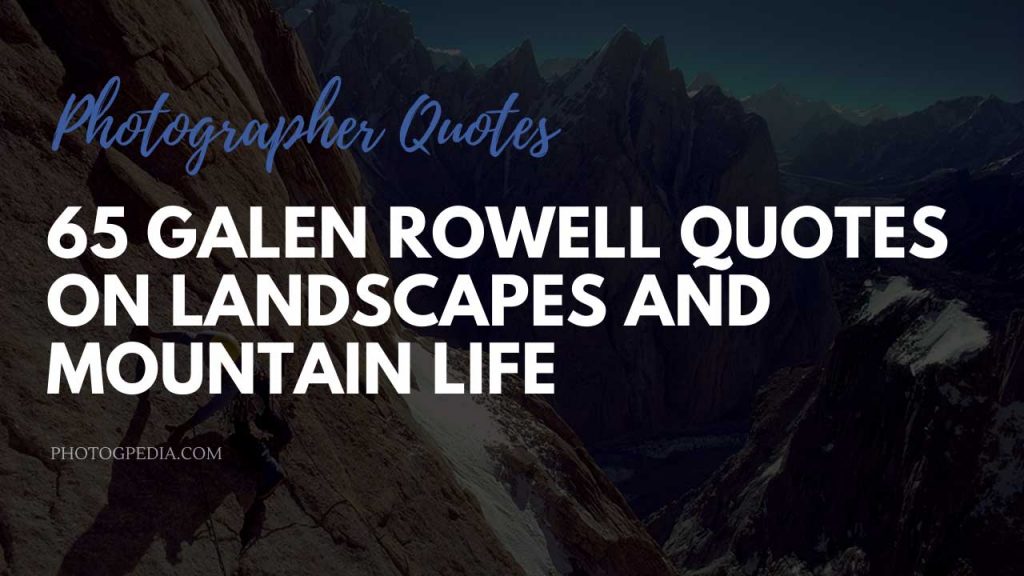Looking for the best Galen Rowell quotes? Then you’ve come to the right place. Below we’ve listed our favorite quotes from the master of landscape and adventure photography to inspire and help take your photography to the next level.
Galen Rowell Quotes
My interest in photography did not begin with a burning desire to see the world through a camera. It evolved through an intense devotion to wilderness that eventually shaped all parts of my life and brought them together.
At the heart of all photography is an urge to express our deepest personal feelings – to reveal our inner, hidden selves, to unlock the artist. Those of us who become photographers are never satisfied with just looking at someone else’s expression of something that is dear to us. We must produce our own images, instead of buying postcards and photo books. We seek to make our own statements of individuality.
Still photographs are better matched to the brain’s long-term way of holding information than any other form of mass communication. The best photographs can capture a whole era in an image or two. Even the finest human mind never recalls everything from previous experience. Memory is a sieve that keeps the nuggets and releases the rubble; I wanted my photography to do the same.
Memory selects single important images, just as the camera does. In that manner both are able to isolate the highest moments of living.
Still photography will hold its present hallowed place in the world of art and communication only as long as it respects the natural integrity of the world it depicts and doesn’t overtly try to compete with high-tech media.
Photography is powered by passion of individual photographers. At the most basic level all photographers are trying to do the same thing: make images that preserve their most deeply felt visual experiences. To deviate from this pursuit of personal truth, regardless of how much money or fame may be at stake, is to risk losing that all-important source of power forever.
Each time I pick up a camera I’m trying to say something. I’m trying to communicate my view of the world and to share those high moments when what I see and what I feel are a single experience. The best images come from a blend of technical discipline and creative thought, a meld of left-brain/right-brain action. Only then can a photographer merge, for an instant, his camera’s way of seeing the world with his own.
Photographs are like gems: the real and the synthetic are often physically indistinuishable, but there is no question to the ultimate value. A photograph that depicts a moment of real life, whether that of a human activity or of the natural world, is of a higher order than the most perfect replication created by or for the camera with luck removed from the formula.
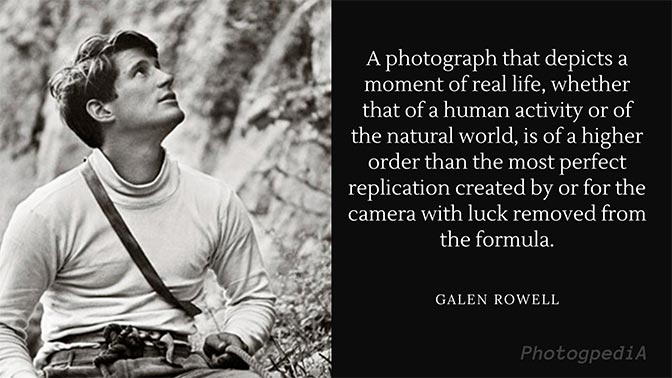
Landscape and Nature Photography
I think landscape photography in general is somewhat undervalued.
Ever since the 1860s when photographers traveled the American West and brought photographs of scenic wonders back to the people on the East Coast of America we have had a North American tradition of landscape photography used for the environment.
These days, most nature photographers are deeply committed to the environmental message
I’m exchanging molecules every 30 days with the natural world and in a spiritual sense I know I am a part of it and take my photographs from that emotional feeling within me, rather than from an emotional distance as a spectator.
The landscape is like being there with a powerful personality and I’m searching for just the right angles to make that portrait come across as meaningfully as possible.
The most interesting parts of the natural world are the edges, places where ocean meets land, meadow meets forest, timberline touches the heights.
A lot of people think that when you have grand scenery, such as you have in Yosemite, that photography must be easy.
… photographers do not merely look, they see. To see, instead of to look at, the desert through a photograph is to make its essential values come alive without resorting to gimmicks such as heavily filtered colors or yellow taxicabs. Unless a landscape is intended as an abstraction, it needs to be absolutely rooted in the integrity of the natural scene.
Photography has traditionally carried with it a cachet of fact, an illusion of captured reality. Today this quality is increasingly endangered by ever more sophisticated ways of manipulating images.
I began to realize that the camera sees the world differently than the human eye and that sometimes those differences can make a photograph more powerful than what you actually observed.
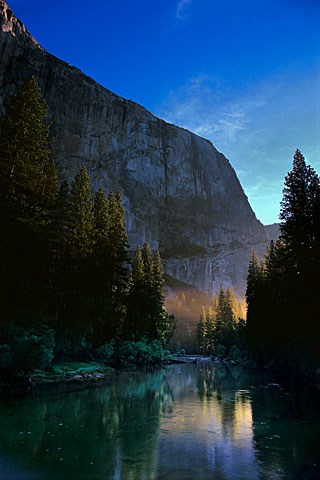
Galen Rowell on Looking for Light
I almost never set out to photograph a landscape, nor do I think of my camera as a means of recording a mountain or an animal unless I absolutely need a ‘record shot’. My first thought is always of light.
When the light is right and everything is working for me, I feel as tense as when making a difficult maneuver high on a mountain. A minute – and sometimes mere seconds – can make the difference between a superb image and a mundane one.
When the magic hour arrives, my thoughts center on light rather than on the landscape. I search for perfect light, then hunt for something earthbound to match with it.
Most amatuer photographers think of landscapes simply as objects to be photographed. They tend to forget that they are never photographing an object, but rather light itself. Where there is no light, they will have no picture; where there is remarkable light, they may have remarkable image picture.
It is easy to forget that light to photographers, like language to writers, is their ony means of artistic expression. Without an understanding of language, combined with imagination and intuition, occassional strings of lyrical words are little more than intermittent accidents. So are photographs made without understanding the language of light.
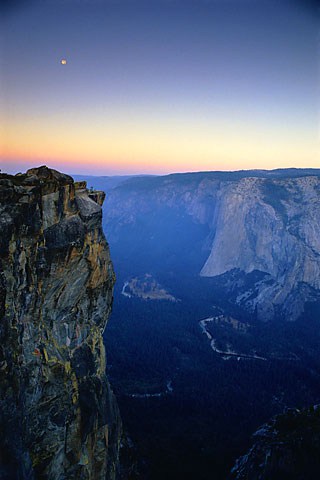
Different Types of Light
As soon as I see that the shadows are gone in an outdoor situation, I know I have soft light and a contrast ratio well within the limits of my film. I can photograph faces without fear of having them go partially black; I can shoot forest detail that would otherwise be splotched with light and dark spots , beyond hope of rendering as a color image.
The clean, even colors that come in nature under a cloudy-bright sky are not found in shadows on clear days or under dark storm clouds. They happen only when nature’s umbrella is white, a situation that can be caused by clouds, fog, light rain, or snow. If I am on assignment and these conditions present themselves, I shift gears to take advantage or the light and consequently make some of my most important outdoor images of people. I f I am in the mountains, I look for the colors of flowers and meadows to come alive. When the air is clear beneath the clouds, there is the potential for making a classic landscape, with mountains in the background and a softly lit foreground scene that doesn’t overpower the whole.
Rainbows are most commonly seen during magic hours because of their optical geometry. They form a halo around the antisolar point, the place directly opposite the sun. Because the primary are of a rainbow lies in a forty-two-degree radius around this point, it is not visible above the horizon unless the sun itself is low in the sky. A full display of a rainbow commonly occurs minutes before sunset when the sun pops out under a layer of clouds after a storm to illuminate falling rain in the distance.
At its best backlighting simplifies what might otherwise be a busy or confusing situations by allowing unnecessary details to drop away in the shadows. Forests can look very complex and uninteresting until backlighting creates beams of light, called crepuscular rays, that have corresponding exaggerated shadows. These “God beams” are among the most beautiful of common opical phenomena.
Sunrise and Sunset Photos
When the magic hour arrives, my thoughts centre on light rather than the landscape. I search for the perfect light, then hunt for something earthbound to match it with. The best images that result from this process look like visual riddles with unexpected answers; and like verbal riddles, visual riddles have been created by starting with answers then working backward.
Some of my favorite images were made after sunset or before sunrise. To work only in direct light is to miss a feast of subtle twilight colors that often become far more vivid on film than they appear to the eye, plus the chance to simulate night photography with some daylight still present.
I treat sunrises and sunsets similarly. Those who travel with me on photo trips often hear my battlecry, “Let’s unset the sunset, ” just before I drive, hike, or run to the higher ground, racing the shadow of last light. A photographer who deals with two or three sunsets a day has more chances to be lucky than a personn who settles for just one.
You only get one sunrise and one sunset a day, and you only get so many days on the planet. A good photographer does the math and doesn’t waste either.
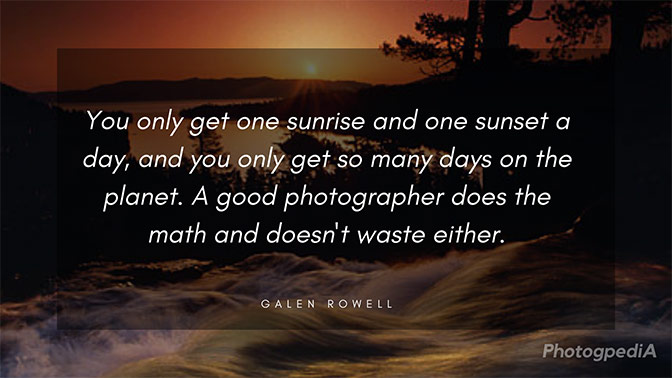
Mountain Light
The publication of Mountain Light: In Search of the Dynamic Landscape in 1986 put my philosophy on the line with the story behind my work. Before Mountain Light the many magazines I had worked for never let me say what really motivated my work, and how different my style of participatory photography is compared to that of an observer with a camera who is not part of the events being photographed. It is the difference between a landscape viewed as scenery from a highway turnout and a portrait of the earth as a living, breathing being that will never look the same twice.
Recommended book: Mountain Light: In Search of the Dynamic Landscape
Photogpedia is an Amazon Associate and earns from qualifying purchases.
Author note: I purchased Rowell’s book used for less than $15. It’s one of the best photography books I own. The book not only features Rowell’s brilliant photography, but also a ton of great information about landscape technique and working on assignment for National Geographic. This is a must own book for all landscape and adventure photographers.
Composition Quotes
In my opinion composition comes boils down to nothing more than pleasing the eye. A good inuitive sense goes a lot further than a headful of rules.
Over the years I have developed a method to avoid thinking in terms of halves, thirds, quarters or the golden [ratio] as I compose a landscape: I always begin by spontaneously balancing the features I have chosen by intuition. I look for the most important convergence of light or form and try to decide where to place it in my picture. If a certain framing feels right, I go with it. Only when it doesn’t, or when I have too many other factors to consider, so I use a rigid procedure to achieve a blanaced composition that does not appear contrived.
Another great rule of composition that I follow faithfully is to include nothing at the edges of my images that will interrupt my viewer’s eye, unless I want such an element there to lead the eye towards the subject (as with a strong diagonal or an S curve). When the main events are in the interior of a photo, the viewer’s eye should be able to run around the perphery without finding anything distracting. Continuous tones without bright highlights or unobtrusive patterns make ideal borders.
Even the most beautiful elements in nature – sunsets, waterfalls, clouds, and rainbows – don’t look their best in photographs when singled out. They are invariably more interesting when juxtaposed against their surroundings; they need something else to locate them in the universe. The balance of the splendid against something ordinary is contrary to a photographers natural inclination. We tend to either single something out or include too many ordinary things.
In photo workshops, I have found that at least 90 percent of the students make a basic compositional mistake. Their best pictures are invariably improved by cropping the foreground. Why? Because we look at a scene with our eyes, our three dimensional vision takes into account the fact that things close to us appear larger because of natural perspective distortion. When we make a photograph, however, we are translating a three-dimensional vision into two, and the foreground will always look overemphasized unless we take that factor into account beforehand.
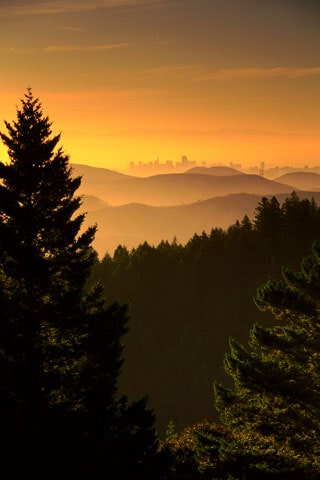
Adventure Photography and Mountain Life
When I go to the mountains, I intuitively know my place in the world much better through these experiences. The more intense they are, the better I know myself, and the more I am able to challenge myself.
My interest in photography did not begin with books or mentors, or with any burning desire to see the world through a camera. It evolved from an intense devotion to mountains and wilderness that eventually shaped all the parts of my life and brought them together.
I began taking pictures in the natural world to be able to show people what I was experiencing when I climbed and explored in Yosemite in the High Sierra.
We mountaineers always live with the feeling that we came on the scene too late.
My mountaineering skills are not important to my best photographs, but they do add a component to my work that is definitely a bit different than that of most photographers.
Contray to what some people may imagine, my photography style does not depend on athletic aability. Most of my best images have come about precisely because of the non-athletic component in my mountain experiences. Even during the most ambitious adventures, I have free time to contemplate my surroundings, from camps, trails, and ledges. Many of [my] photographs… were made in locations readily accessible to people whose reasons for being in the wilderness are distinctly non-athletic.
I am intent on preserving the integrity of still photography… I recognize that some of my photographs may seem unreal to people that have never experienced the many nuances of mountain light, but all are natural events. Those high moments of mountain experience, the ones that would burn themselves into my memory whether or not I have a camera, are what I want to put on film, or whatever media for recording still images may emerge in years to come.
I remember when an editor at the National Geographic promised to run about a dozen of my landscape pictures from a story on the John Muir trail as an essay, but when the group of editors got together, someone said that my pictures looked like postcards.
Often when I walked alone in the mountains, I tried to make sense out of the two halves of my life. What went on in the city during the week seemed chaotic and unrelated to the events in my mountain world.
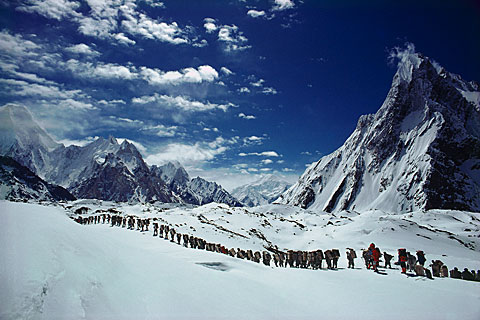
Photo Essays and Writing
The reason that I keep writing is that all my most powerful messages about the fates of wild places that I care about need to have words as well as images.
Theres no question that photographs communicate more instantly and powerfully than words do, but if you want to communicate a complex concept clearly, you need words, too.
Today, I’m very careful not to mention very specific locations when I write or give captions.
In John Muir’s time those who traveled through the mountains recorded their experiences in words or sketch pads. Muir did both, but his words are better remembered. If he were alive today, I have little doubt that he would be a wilderness photographer.
… whether I consider myself a writer or a photographer: “I spend two-thirds of my time on writing and one-third on photography; two-thirds of my income is from photography, one-third from writing.” By practicing both trades at once I was able to compare them and thereby gained a new understanding of the startling effects they have had on one another over the last century.
Galen Rowell on Equipment
Some of the time I use a tripod for static scenes and long telephotos, while other times – when I need to go very light ib wilderness adventures – I make do as best I can without one. The same principle holds true for all my photo equipment. The fact I own an item – a lens, a filter, or a tripod – doesn’t mean I use it all the time. Sometimes I take it in the field with me and never use it; it may stay in the car or at basecamp.
The most commonly used lens in my collection is a [Nikon] 24mm f/2.8. It is a carefully weighted compromise that gives me just enough interplay of foreground and background while keeping parallax distortion within control. A 28mm lens is simply not wide enough to give me the feeling I want most of the time.
I use the Nikon Series E 75-150 zoom almost as much as the 24mm lens. Its relatively fast f/3.5 aperture and light weight make it a perfect short telephoto for outdoor use.
The reason 35mm image doesn’t look like the 4-by-5 image is more of a result of method than of equipment. When I come across a still landscape that moves me, I pretend my Nikon is a bigger camera. I heft it onto a tripod, fool with composition for long minutes, shoot at f/16 to maximize depth of field, and get results that resembles in every respect what I would have gotten with a bigger camera, except the size of the film grain in enlargement. Images made in this manner regularly stand up to poster-size enlargements.
Rowell died in 2002 in a plane crash while returning from a photography workshop in Alasaka. Sadly, the pioneering outdoor photographer wasn’t around to see the photography world make the switch from film to digital. Here’s what Rowell said about the future of cameras a decade before:
Small, portable digital cameras that exceed the performance of an off-the-shelf Nikon using 35mm slide film are further away from current reality than the proposed NASA manned Mars mission, although I expect both to happen sometime during my lifetime.
To see a full list of Rowell’s cameras, lenses and filters, check out the Galen Rowell’s Camera Bag page on the Mountain Light website.
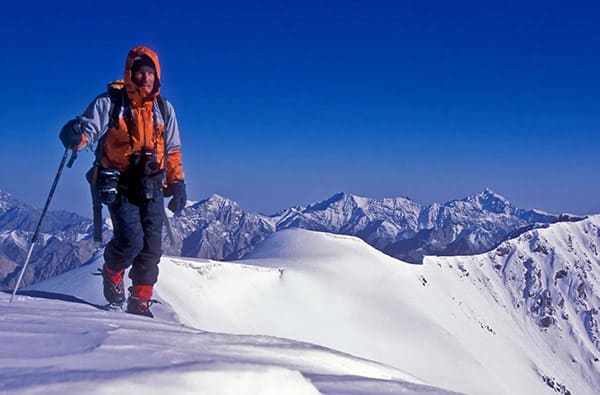
Galen Rowell Quotes for Better Photography
My advice for climbers or photographers is to really tune into your own passions and not just what other people are doing or aren’t doing. Figure out what works for you, what turns you on, what gives you the greatest amount of energy and feeling of satisfaction.
One of the biggest mistakes a photographer can make is to look at the real world and cling to the vain hope that next time his film will somehow bear a closer resemblance to it… If we limit our vision to the real world, we will forever be fighting on the minus side of things, working only too make our photographs equal to what we see out there, but no better.
Before I press the shutter release, I think about the validity of my subject. Photographs can lie as surely as words, and just as with writing, making a photogaph implies that the photographer understands what his photograph says. My rule of thumb is to hold back from making an exposure unless it directly involves me either intellectually or emotionally, or in both ways.
And most of my early pictures failed but about one in a 100 somehow looked better than what I saw.
Photography was a means of visual expression to communicate what I had seen to people who weren’t there. At first I was disturbed that 99 percent of my images didn’t look as good as what I had seen. The other one percent, however, contained some element–a beam of light, a texture, a reflection–that looked more powerful on film than to my eye. Without this I never would have been drawn toward photography as a career. I became fascinated with trying to consistently combine photographic vision and a visualization in my mind’s eye to make images that exceeded the normal perception before my eyes.
What I mean by photographing as a participant rather than observer is that I’m not only involved directly with some of the activities that I photograph, such as mountain climbing, but even when I’m not I have the philosophy that my mind and body are part of the natural world.
I like to feel that all my best photographs had strong personal visions and that a photograph that doesn’t have a personal vision or doesn’t communicate emotion fails.
I cannot overemphasize the importance of paying close attention to poor photos as well as to good ones, for it is in the rejects that our own conceptual errors are the most apparent. Too many of us get back our slides, pull out the good ones and banish the rest.
Luck plays a role in all great photographs, especially those in the natural world; yet it is not to be found in the indexes of photography manuals or on the agendas of photography classes and workshops. Luck is what makes photography an entirely different medium from art forms based only on planned creative acts.
Photography succeeds not when the original vision is created photographically, but when the photograph is able to evoke or re-create a similiar vision in the mind of each viewer. If the re-creation is not understood or not relevant or not powerful enough, the image fails. But if the special unity of composition found by the photographer triggers strong emotions, the image has a chance of success.
In the clip below, Rowell explains how he captures his remarkable photos. Also, check out episode 30 (opens in new tab) where he shares his top tips for photographing the great outdoors.
What’s your Favorite Galen Rowell Quote?
Have a favorite Galen Rowell quote from the list? Let us know in the comment section below.
Don’t forget to bookmark this page, or print it out, and refer to it next time you need some inspiration. If you’ve enjoyed the article, we would be grateful if you could share it with other photographers.
To learn more about Rowell’s landscape and outdoor photography, check out the Mountain Light website. Unfortunately the gallery links on the website don’t seem to be working, however you can still view his images using the Internet Archive website.
Looking for more words of wisdom from master photographers? Visit the quotes section of Photogpedia for more great photography quotes.
Related Quote Articles:

